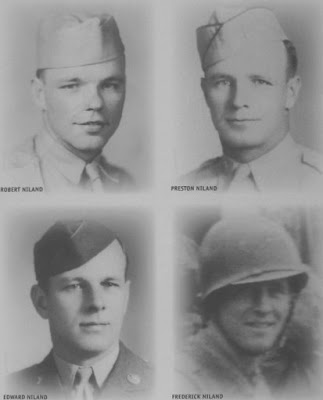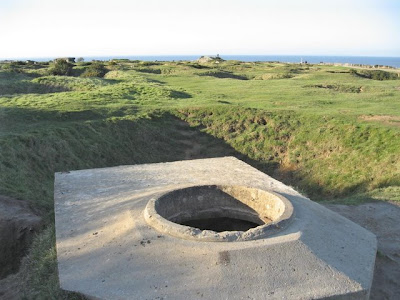Sunday 7th December 2008, Bayeux, Normandy
On June 6th 1944 the coast of Normandy was the scene of the largest seaborne invasion in the history of the world, either before or since. In 1940 France had surrendered to Hitler and throughout the Second World War it was thus an occupied nation. Since then, no British military force had successfully entered the country - though reconnaissance personnel had been parachuted in, and airmen, shot down over France, had been rescued and smuggled back to Britain with the aid of the French Resistance.
In 1943, Winston Churchill agreed with America to launch an attack somewhere along the French coast, together with the support of Canada, Polish troops in exile and the Free French, with additional representation from the exiled soldiers of Czechoslovakia, Greece, Norway and the Netherlands. The undertaking would have been impossible without the support too of the French Resistance, working within France, gathering information, and hindering the German troops by carrying out carefully co-ordinated acts of sabotage to transport and communication links. On D-Day, 133,000 Allied troops and 23,000 airmen landed on the Normandy coast.
Just a few kilometres from Bayeux lie the beaches where, after months of careful and highly secret preparation, the Allied Forces launched their attack from Southern England and finally regained a toehold on the continent of Europe. Stretching along the coast for fifty miles, from the Cotentin Peninsula to Ouisterham on the mouth of the River Orne, lie the Plages de Débarquement where the troops came ashore under heavy resistance. The British forces were concentrated to the east, at the beaches of Gold and Sword. They flanked Juno Beach where the Canadian forces were concentrated. Their objective was to capture the city of Caen. The American forces were concentrated to the west at Omaha and Utah and they suffered the worst casualties, encountering strong resistance as they attempted to scale 30 metre high cliffs at the Pointe du Hoc using grappling irons. By the end of the day, right along the coast the initial objectives had been achieved. The liberation had begun.
Over the next few weeks the fighting was heavy and deadly as the Allies slowly advanced. Bayeux was captured completely intact by British troops on 7th June, before the Germans fully appreciated what was actually happening. It thus became the first town liberated in Europe and, unlike almost every other town and village in this part of Normandy, has retained all of its charm, its wonderful historic buildings unscathed. Near where we are living is the Place Charles de Gaulle. There is a monument there commemorating the first public address on French soil made by the General after returning from his exile in London, just a week after D-Day. He established himself in the nearby Sous-Prefecture and for a brief while, until Paris was regained, Bayeux became the seat of French government.



Caen did not fall until mid July, following intensive Allied bombing that resulted in enormous civilian casualties. Meanwhile the American forces gradually liberated the Cotentin peninsula and Brittany before advancing southwards towards Falaise. Here they met up with the British and Canadian forces. The German troops were squeezed between them and forced to retreat rapidly, leaving the Allies to march on to liberate Paris. By mid-August over 2,000,000 Allied troops has landed along the shores of Normandy!
The planning that went into the operation is mind-blowing! Co-ordinating and training the troops, commissioning the ships, weapons and equipment, deceiving the Germans into believing the attack would be launched elsewhere, and most of all perhaps, actually managing to keep the plans secret to the extent that the German forces were taken completely by surprise when the attack was finally launched!
Arromanches is only seven miles north of Bayeux. Nearly sixty-five years on, the remains of the temporary harbour are still there. Huge concrete caissons, codenamed Mulberries, were built in England and floated across the Channel. They were then filled with seawater and sunk onto the beach to form an artificial harbour and a temporary roadway to the shore for tanks and vehicles to be unloaded. Soon after, fuel was provided from England through a "pipeline under the ocean" known as PLUTO.





The invasion and its human toll are still very much in evidence in the countryside around here, and also in the minds of the older people. While the Normans naturally welcomed their liberators, many, many thousands of helpless citizens died in the fighting, mostly from Allied bombardment.
Many of the troops arriving to liberate Europe never made it beyond the beaches. Walking along the sands today it is impossible to fully appreciate the bravery of so many young men carrying their weapons and back packs, wading in from their landing craft under deadly fire from the heavy artillery and guns of the German coastal defences. There are so many horrific tales of carnage as well as stories of individual acts of heroism and self sacrifice.
There are carefully tended military cemeteries scattered across the peaceful Normandy countryside where every white headstone is dated 6th June or a few days later. Most were in their 20s or early 30s but yesterday, on one young soldier's grave we were shocked to see he was just 16! It is the bravery of such young men to which we owe the last 65 years of relative peace in Europe. It certainly makes you think!
And what did Hitler ultimately achieve from his policy of ruthless annexation? Of his conquests in Western Europe, all Germany ended up with in Normandy was a few acres of land at La Cambe in which to bury its dead soldiers!
Britain has thirteen cemeteries in Normandy, one being here in Bayeux with 4,382 graves. The names of those with no known grave are listed on a huge monument opposite the cemetery. Across the top is an inscription in Latin reading something like "We who were conquered by William have liberated the land of our victors." Other British cemeteries are quite small and perhaps to be found in a quiet field attached to an ancient farm in the depths of the countryside. Such was the one we found yesterday at Jerusalem, near the Abbaye de Mondaye, with 47 British graves and three Czech ones. Almost all were from the Durham Light Infantry and had died within a couple of days of each other. Frequently too in the British cemeteries we have seen sections for German and Polish war dead.





The main Canadian cemetery at Beny-Reviers has 2,044 graves while the Polish cemetery is at Langannerie, between Caen and Falaise, has 650 graves.
The US honour their dead at one huge cemetery at Colville-sur-Mer. It lies beside the sea on the spot where many of them would have disembarked and fought their way ashore. It is stunningly impressive with 9,386 white marble headstones standing in perfect alignment in the immaculate green lawn overlooked by a massive memorial colonnade, a lake and a garden of remembrance for the 1,557 missing dead. Another memorial overlooks the landing beaches where there is yet a further memorial to the Canadian minesweepers who cleared the Channel to enable the invading American forces to land. There is also a visitors' centre outlining the events of D-Day at Utah and Omaha with films, personal testimonies and photos. Amongst the photos we found four brothers, two of whom were killed on consecutive days, a third was reported missing and the fourth was returned home on compassionate grounds. It formed the basis for the film "Saving Private Ryan."







Impressive as all these facts and figures are, they represent only those whose bodies that were not returned to their homelands for burial. Great as the overall Allied losses were, they were surpassed by those of the German troops. Their bodies are either buried alongside those of their former enemies in British cemeteries, or in the Deutscher Soldaten-Friedhof at La Cambe where 21,202 are buried. The cemetery is very striking indeed, particularly when seen late on a wet December afternoon with nobody around except a guardian sweeping the fallen leaves away from the rows of plaques in the grass, each representing several named soldiers. Groups of low, black basalt crosses are spaced around the cemetery while in the centre is a high mound topped by two towering figures. It covers a communal grave. The appearance and atmosphere are both very different from those found in the Allied cemeteries.


Today we walked out onto the headland of La Pointe du Hoc where the Americans landed. Further east the coastline is flat and sandy but here a ridge of sheer rock juts out into the sea. The Germans thought it invincible. The Atlantic Wall ran along the top. This was a series of defensive blockhouses, artillery emplacements and trenches stretching across Northern Europe, from Scandinavia to the Spanish border, to protect against any threat of attack from the sea.

The first wave of 225 American troops sent to scale the cliffs, precariously hanging from rope ladders, lost the element of surprise but somehow managed to achieve their objective, namely gain the headland, put the artillery out of action and hang on until support arrived. By the time it did there were only 90 soldiers left alive, many of them injured.




The headland is kept today pretty much as it was left after the initial attack. Heavy bombardment from the sea and air "softened up" the German defences and they were forced to move back from the cliff top, putting their heavy guns out of action at the time of the assault. Walking around the cliffs in the afternoon sunshine it was awesome to see the ground completely riddled with huge craters, trenches, broken bunkers and destroyed gun emplacements. The bunkers were three feet thick and several had received direct hits. Others were untouched and it was possible to climb down into then to explore the huge, subterranean concrete chambers beneath or stand where the guns would have been and look out over the sea, imagining seeing warships, minesweepers and landing craft in their thousands sailing relentlessly towards the shore.










These are some of the impressions we have received over the last couple of days. Up around Caen, where the British troops landed, there were different but equally courageous activities taking place. This account is seen however from the perspective of where we are currently staying in Bayeux.
We would not wish anyone to imagine that we are obsessed by War and hope this account is not seen as glorifying it. We realise there have been numerous reports of troubles across war-torn Europe in our blogs but it is part of our history and it is impossible to travel as we have done and remain unaffected by it. Certainly in this instance the cause was obvious and the outcome has ensured many years of relative peace, at least for the countries of Western Europe, freed from the tyranny of Nazi domination.
